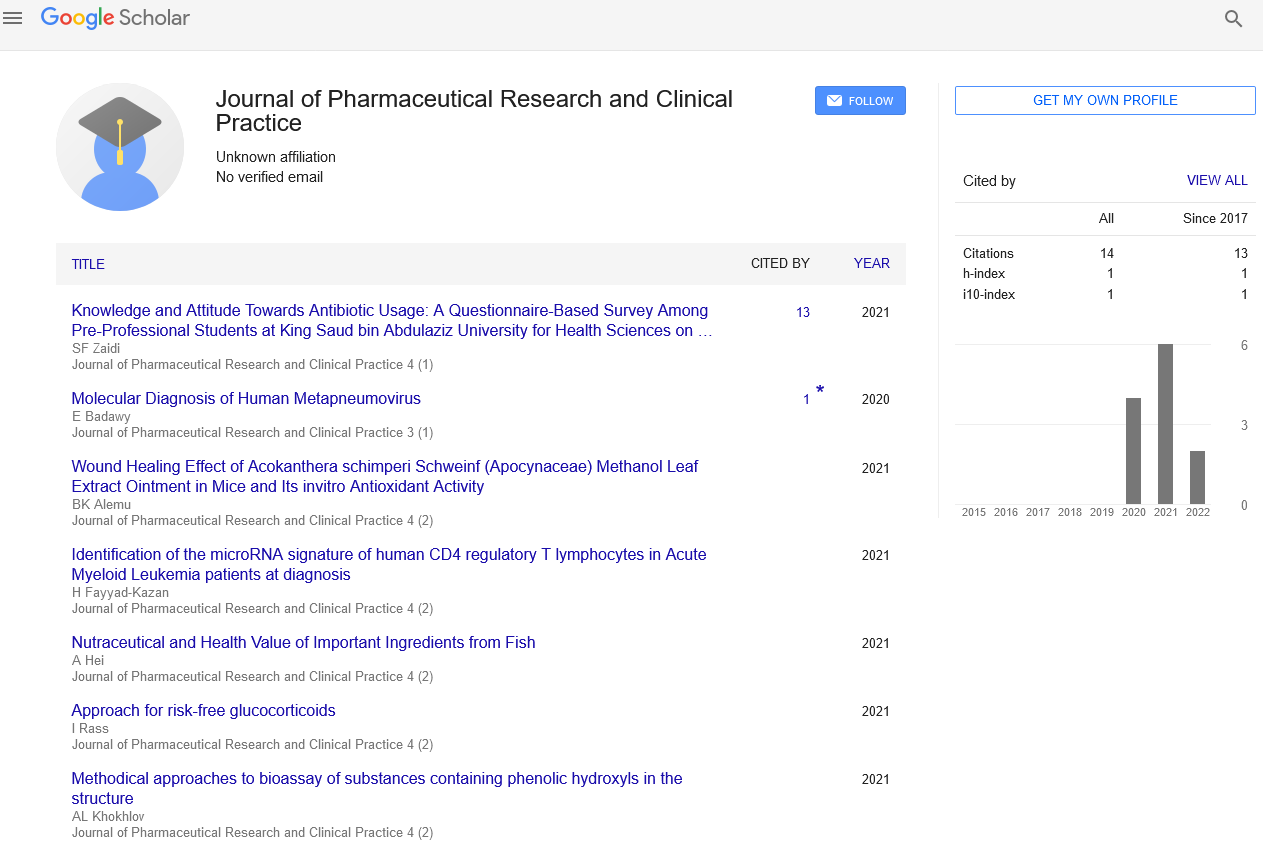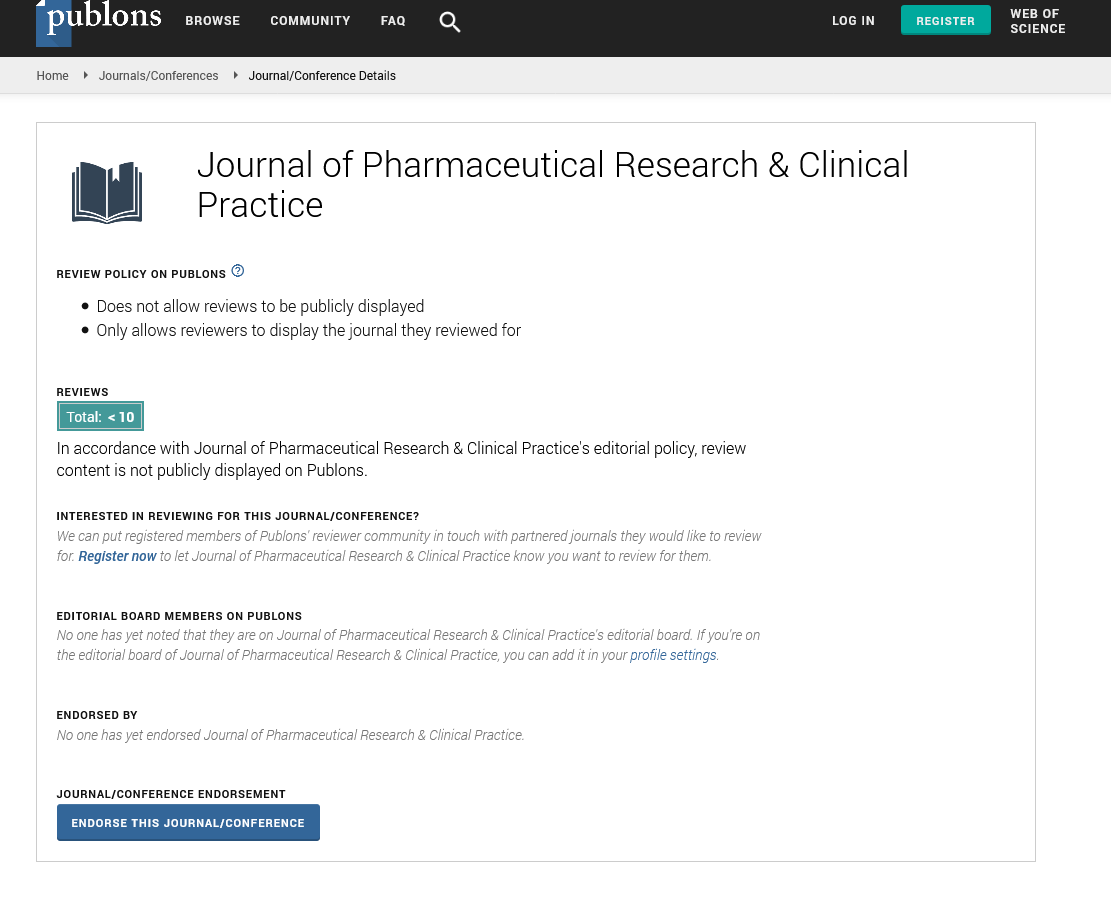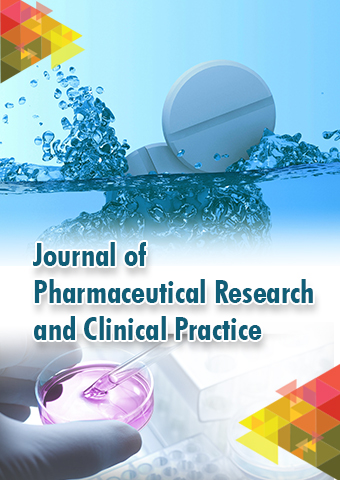Mini Review - Journal of Pharmaceutical Research and Clinical Practice (2023) Volume 6, Issue 2
The effectiveness of pharmacometrics and quantitative systems in pharmaceutical research
Gopal Dixit*
Department of pharmacology, University of Munich, Germany
Department of pharmacology, University of Munich, Germany
E-mail: gopaldixit@edu.in
Received: 01-Apr-2023, Manuscript No. jprcp-23-95400; Editor assigned: 03- Apr-2023, PreQC No. jprcp- 23-95400(PQ); Reviewed: 17- Apr -2023, QC No. jprcp-23-95400; Revised: 24- Apr -2023, Manuscript No. jprcp-23-95400 (R); Published: 30- Apr -2023; DOI: 10.37532/ jprcp.2023.6(2).19-21
Abstract
Pharmacokinetics and pharmacodynamics with mechanistic models of physiology in health and disease to predict effects at the system level, quantitative systems pharmacology (QSP) models are an important aspect of pharmaceutical and clinical research. Mechanistic modeling and population approaches have traditionally been included in the quantitative clinical pharmacology toolbox, which is also known as pharmacometrics. However, the current environment necessitates the optimization and utilization of multiple models simultaneously. Parallel synchronization, cross-informative use, and sequential integration are three methods for combining QSP and pharmacometrics models that are discussed in this section. These methods are illustrated by a number of drug development case studies. Even though these methods are being used more and more in drug development, a true convergence of QSP and pharmacometrics that fully uses their synergy will require new tools and methods that make it easier to integrate technical aspects, as well as scientists with different modeling skills who can use cross-discipline strategies. This convergence will be made possible by extending the methods that have been used in each approach and adding additional resources like machine learning models, data-at-scale, end-to-end computation platforms, and real-time analytics.
Keywords
Quantitative system pharmacology • Pharmacometrics • Quantitative pharmacology
Introduction
In pharmaceutical research and development, quantitative systems pharmacology (QSP) models are increasingly being used to facilitate the clinical development of novel therapeutics. To predict systemic effects, QSP combines pharmacokinetics/pharmacodynamics (PK/PD) with mechanistic models of physiology in health and disease. QSP computational modeling has the potential to improve clinical trial success by providing valuable insight into crucial aspects of drug efficacy/safety and outcome improvement when used appropriately. The development of preclinical and clinical experiments and clinical trials, the generation and exploration of new mechanistic hypotheses regarding an observed effect, and the provision of insight from preclinical to clinical translation, reverse translation, or cross-disease translation are additional applications [1-3]. Other applications include gaining confidence in the rationale of existing and/or emerging targets, identifying optimal or alternative targets, and designing preclinical and clinical experiments and clinical trials.
Model-informed drug development (MIDD) is currently a major component of the quantitative clinical pharmacology roadmap. Data at the cellular (mechanistic), tissue (organs and cells), animal, human physiology and disease biology, and population level are all included in the modeling approaches. Mechanistic modeling and population approaches, collectively known as pharmacometrics, have always been part of the quantitative clinical pharmacology toolbox [4]. These likewise incorporate longitudinal information and the capacity to remember the unique parts of that information for the models. Wearables and digital health, real-world data (RWD), artificial intelligence/machine learning (AI/ML), and algorithms for personalized treatment and dosing are among the emerging fields currently in development to collect and manage these data. Mechanistic modeling and population approaches comprise the quantitative clinical pharmacology toolbox as a whole. Also, fit-forreason displaying apparatuses and synchronous incorporation of various methodologies have been adjusted for addressing explicit clinical inquiries.
In order to demonstrate the current state of integration between the approaches, this perspective will provide examples of QSP integration with pharmacometrics. These contextual analyses incorporate equal synchronized application, cross-instructive use, and successive mix. In quantitative clinical pharmacology, these methods are being widely used. Machine learning models, data-at-scale, end-to-end computation platforms, and realtime analytics are just a few of the novel tools and methodologies that will be needed for a deeper convergence of QSP and pharmacometrics [5-7]. In order for such cross-disciplinary quantitative science to truly succeed and have an impact on decision-making, scientists will need to have an open mindset, diverse modeling expertise, and strategic communication skills. This procedure was conveyed during the improvement of mosunetuzumab, a bispecific neutralizer focusing on both CD20 and CD3 that has as of late been supported by the FDA for treatment of backslid/headstrong follicular lymphoma. Mosunetuzumab activates T cells and kills B cells when it binds to CD3 on T cells and CD20 on B cells, including those with malignant lymphoma. Mosunetuzumab has been demonstrated to be exceptionally powerful in animating Immune system microorganism intervened dispensing with of CD20-communicating B-cells, including essential patient-determined lymphoma cells, both in vitro and in vivo. Following exposure to mosunetuzumab, a cascade of immune activation results in T cell proliferation, trafficking, and the release of cytokines. Mosunetuzumab exposure, on the other hand, can cause cytokine-related toxicities and Cytokine Release Syndrome (CRS), which reduces the therapeutic dose for patients due to the potent activation of T cells.
To reduce the toxicities associated with mosunetuzumab, parallel synchronization methods were utilized. To comprehend CRS via IL6 in patients taking mosunetuzumab and to guide dosing optimization, the bottom-up QSP approach and the top-down Population PK/PD approach were utilized. In this case study, QSP modeling was used to explore dose levels and regimens for mosunetuzumab in silico using data from translational studies on cynomolgus monkeys and human biology [8]. The blood, bone marrow, spleen/lymph nodes, and tumor are just a few of the physiological compartments that this model describes for T and B cell kinetics and trafficking. When little or no clinical data were available in the early stages of clinical development, QSP model predictions were crucial for guiding dose selections and step-up dosing design in the Phase 1 study. The model was additionally adjusted utilizing clinical information and applied to illuminate suggested Stage 2 portion (RP2D). Drug development has traditionally been guided by popPK/PD and exposure-response modeling, which describe the variability of drug/molecule kinetics and responses across a patient population. For a PopPK/PD or exposure-response model to be accurate, a large enough sample size is needed, especially for the noisy IL6 response and CRS in diverse cancer patients.
Discussion
To fully realize the integration and synergistic potential of these approaches, much work remains, despite the promise of their convergence. As shown in the preceding examples, the current modeling landscape includes a variety of approaches that are frequently utilized simultaneously or separately [9-10]. A multiplicative and combinatorial approach is required if predictive modeling is to be utilized to its full potential. Predicting PK, PD, mechanism-of-action, and clinical outcomes in a coordinated manner that effectively marries biological/mechanistic knowledge with data from preclinical, clinical, literature, and realworld will, we anticipate, result in greater value and a more robust ability to predict these outcomes. The ability to massively integrate data sets from disparate clinical trials to guide future trials is one advantage of modeling. The various human clinical preliminaries pertinent to a given medication improvement program are priceless for the fast and effective clinical improvement of new sub-atomic elements. However, advanced computational modeling methods, such as machine learning, must be combined with human biology, the therapeutic potential of novel drug modalities, massively scaled and high-resolution data, and human biology. Clinical development will be enhanced and algorithms for personalized treatment and dosing will become a reality as a result of this complete multiplicative integration of approaches.
Declaration of Competing Interest
The authors declared that there is no conflict of intrest.
Acknowledgement
None
References
- Panda VS, Naik SR.Cardioprotective activity of Ginkgo biloba phytosomes in isoproterenol-induced myocardial necrosis in rats: A biochemical and histoarchitectural evaluation. ExpToxicol Pathol. 60, 397–404(2008).
- Mazzotti A, Caletti MT, Sasdelli ASet al.Pathophysiology of non-alcoholicfatty liverdisease. Lifestyle gutgeneinteraction.Dig Dis. 34, 3–10 (2016).
- Kaski JP, Syrris P, Burch Met al.Idiopathic restrictivecardiomyopathyin children is caused bymutationsin cardiac sarcomere protein genes.Heart. 94, 1478–1484 (2008).
- Kotronen A, Westerbacka J, Bergholm Ret al.Liver fat in the metabolic syndrome.J Clin Endocrinol Metab. 92, 3490–3497 (2007).
- Mogensen J, Kubo T, Duque Met al.Idiopathic restrictivecardiomyopathyis part of the clinical expression of cardiac troponin I mutations.J Clin Invest. 111, 209–216 (2003).
- Kwanten WJ.Role of autophagy in the pathophysiology of nonalcoholicfatty liverdisease: a controversial issue.World J Gastroenterol. 20, 7325 (2014).
- Xing Y, Ichida F, Matsuoka Tet al.Genetic analysis in patients with left ventricular noncompaction and evidence for genetic heterogeneity.Mol Genet Metab. 88, 71–77 (2006).
- Faraji Hormozi S, Saeedi AA, Aminianfar Met al.Studying the Frequency of NosocomialInfectionand its Relative Factors in the Intensive Care Unit of Hospitals Based Upon NNI System.Eurasian J Anal Chem. 13, (2018).
- Dellefave LM, Pytel P, Mewborn S et al.Sarcomeremutationsincardiomyopathywith left ventricular hypertrabeculation.Circ Cardiovasc Genet. 2, 442–449 (2009).
- Morita H, Rehm HL, Menesses Aet al. Shared genetic causes of cardiac hypertrophy in children and adults.N Engl J Med. 358, 1899–1908 (2008).
Indexed at,Google Scholar ,Crossref
Indexed at,Google Scholar ,Crossref
Indexed at,Google Scholar ,Crossref
Indexed at,Google Scholar ,Crossref
Indexed at,Google Scholar ,Crossref
Indexed at,Google Scholar ,Crossref
Indexed at,Google Scholar ,Crossref
Indexed at,Google Scholar ,Crossref
Indexed at,Google Scholar ,Crossref


